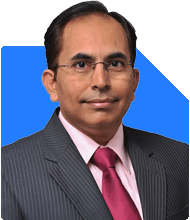Janak Patel |72 Answers |Ask -Follow
MF, PF Expert - Answered on Jul 15, 2025
He is the CEO and founder of InfiniumWealth, a firm that specialises in designing goal-specific financial plans tailored to help clients achieve their life goals.
Janak holds an MBA degree in finance from the Welingkar Institute of Management Development and Research, Mumbai, and has over 15 years of experience in the field of personal finance. ... more

Hi Sir/Madam, I'm 35 yrs old married man, no children, Working as Qa analyst from past 13yrs. I'm earning 1-Lack per month. I have no emis and no good savings. But rent is 25k per month I may go for house loan maybe 20-Lakhs to support my parents house But I'm worried about my future due to working in IT as QA and uncertainty about job security Can you please suggest me how can I save money and pension plan Any suggestions will be really helpful
Based on the information provided, its difficult to provide specific responses. Even then, let me try to guide you with some pointers.
Savings -
As I understand your income and expenses do not leave any saving at this time. With 1 lakh income and 25K rent, you have 75k for other expenses. So first start by looking at these, create a budget for various expenses and see if there is any potential to make adjustments and arrive at saving a few thousands. Even a saving of 2k every month has a potential to build 10 lakhs in 15 years. So no amount is too small. Start small and keep looking for ways to save more with time.
Rent is also something to think about. Is there anyways to reduce it, a smaller house or another area or something that can work for you. When you consider new place keep in mind the over all expense you will incur not just rent, e.g. travel expenses. Overall there should be a benefit in terms of real savings in hand every month.
Loan -
Going for a loan to support your parents house will put additional burden on your budget. Do they live in the same city, if so is there an option to live with them. This can help service EMI with the rent saved.
Empower your spouse -
Another option to consider is your spouse's potential to contribute to the household income. You can encourage her towards something that she can start either a job or something on her own, may be tuitions or any other interests, anything that can generate a little more income to support/increase your savings.
Career -
As for your own future in IT, I can understand it may look challenging. Look for additional skills you can develop on the job. Many organizations have career growth options with trainings and new areas of focus where they would prefer an existing employee they can train and utilize. So look within your organization and even outside. Developing new skills can be 1 way to stay relevant in IT. Keep yourself updated with new tools and techniques to get an edge over others.
Also consider any other areas of interest/expertise you have or can develop for an alternate career. I have been in the IT industry too for a long time. Somewhere in the middle of my IT career I developed interest towards finance and specifically personal finance area and pursued it with passion and eventually I started it as a profession/business.
So look for your areas of interest.
Thanks & Regards
Janak Patel
Certified Financial Planner.
You may like to see similar questions and answers below
Ramalingam Kalirajan |10906 Answers |Ask -Follow
Mutual Funds, Financial Planning Expert - Answered on Jun 21, 2024
Ramalingam Kalirajan |10906 Answers |Ask -Follow
Mutual Funds, Financial Planning Expert - Answered on Jan 31, 2025
Ramalingam Kalirajan |10906 Answers |Ask -Follow
Mutual Funds, Financial Planning Expert - Answered on Jul 07, 2025
Ramalingam Kalirajan |10906 Answers |Ask -Follow
Mutual Funds, Financial Planning Expert - Answered on Sep 11, 2025
Reetika Sharma |432 Answers |Ask -Follow
Financial Planner, MF and Insurance Expert - Answered on Sep 17, 2025
Ramalingam Kalirajan |10906 Answers |Ask -Follow
Mutual Funds, Financial Planning Expert - Answered on Dec 19, 2025
Nayagam P P |10859 Answers |Ask -Follow
Career Counsellor - Answered on Dec 19, 2025
Ramalingam Kalirajan |10906 Answers |Ask -Follow
Mutual Funds, Financial Planning Expert - Answered on Dec 19, 2025
Ramalingam Kalirajan |10906 Answers |Ask -Follow
Mutual Funds, Financial Planning Expert - Answered on Dec 19, 2025
Ramalingam Kalirajan |10906 Answers |Ask -Follow
Mutual Funds, Financial Planning Expert - Answered on Dec 19, 2025
Radheshyam Zanwar |6751 Answers |Ask -Follow
MHT-CET, IIT-JEE, NEET-UG Expert - Answered on Dec 19, 2025
Radheshyam Zanwar |6751 Answers |Ask -Follow
MHT-CET, IIT-JEE, NEET-UG Expert - Answered on Dec 19, 2025
Samraat Jadhav |2514 Answers |Ask -Follow
Stock Market Expert - Answered on Dec 18, 2025
Reetika Sharma |432 Answers |Ask -Follow
Financial Planner, MF and Insurance Expert - Answered on Dec 18, 2025
Reetika Sharma |432 Answers |Ask -Follow
Financial Planner, MF and Insurance Expert - Answered on Dec 18, 2025


























